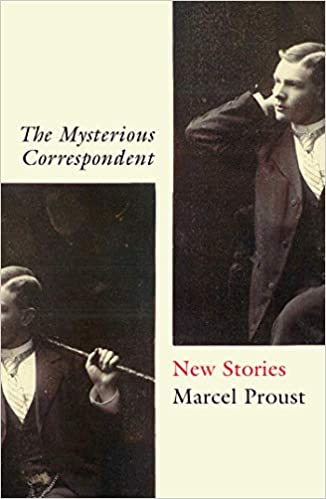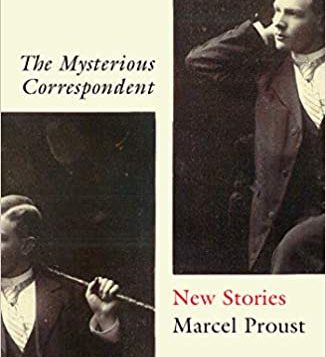 THE MYSTERIOUS CORRESPONDENT
THE MYSTERIOUS CORRESPONDENT
New Stories
by Marcel Proust
Translated by Charlotte Mandell
Oneworld Publications
138 pages, $24.99
MARCEL PROUST is having a very good year: 2021 marks the sesquicentennial of his birth as well as the centenary of his winning the Prix Goncourt—France’s pre-eminent prize for literature. It also marks the publication in English of a book of new work, The Mysterious Correspondent—“new” being a relative term, as the writing itself dates from the 1890s. If that weren’t enough, the recent rediscovery of the legendary “Seventy-Five Pages,” Proust’s personal guide to his masterwork, the seven-volume À la recherche du temps perdu, has definitely sent things over the top.
But where has all this stuff come from, and why has it taken so long to show up? You may well wonder. Proust’s magnum opus had one of the longest gestations of any novel in history. Written between 1909 and 1922, the year of his death, In Search of Lost Time was finished but not polished when Proust died. It was left to his brother Robert to edit the final three titles, the last appearing in 1927. As recently as 1986, a major revision by Proust of one of the later manuscripts, The Fugitive, was discovered. Then, in 2018 a number of additional papers from his estate came to light after the death of publisher Bernard de Fallois, including The Mysterious Correspondent, as well as the aforementioned “Seventy-Five Pages,” long since considered lost but now happily found.
The real mystery of Proust, however, is how and when an otherwise unremarkable young man and society gossip columnist developed the extraordinary talent that led to the creation, in the last years of his life, of what many consider the greatest work of 20th-century fiction. The fact is, Proust had been writing almost nonstop since he was a young man. His early works include the unfinished novel Jean Santeuil and the hybrid Contre Sainte-Beuve, part novel and part art criticism, both unpublished during his lifetime. His first book-length work, a collection of shorter pieces, Pleasures and Days, was published in 1896. It is from this source that the work under review derives, culled from its pages by Proust himself.
Why would a young writer discard the equivalent of a slim volume of stories just as his career was beginning? The reasons are obvious: the subject matter and their timing. In 1896, Proust was 25 years old. It was just a year after the trial of Oscar Wilde, whom Proust had met, and the topic of homosexuality, which informs most of these stories, was fraught. A quarter century later, he had further qualms about publishing Sodome et Gomorrhe, the sixth volume of Recherche, believing the public was still not ready for it.
So how gay are these stories? A little and a lot. The subject matter is clear, but there are no overtly sexual passages. It would be more accurate to classify them as emotionally or psychologically queer. Characters pine for other characters, but without attaining their desires. (It’s a familiar theme with Proust. In its way, Recherche is a 3,000-page exercise in unrequited desire.) The translation is refreshingly clear, the textual notes ample and impressively researched, if occasionally showy. For full reading pleasure, however, readers should tackle the stories first and turn to the notes later. All nine works in the collection are short. Only two of these—the first and last—do not deal with sexuality in any notable way.
 In the first piece, “Pauline de S.,” the narrator visits a dying friend and is amazed to learn that in her final days she prefers frivolous activities to meditations on deeper matters. The title story, the most substantive in the collection, runs to melodrama. A woman is literally consumed with shame over her love for another woman. Guilt stalks this tale like the Spectre of Death. A moralistic turnaround, in which the object of desire consults a priest on where her duty lies with respect to her friend, points up the oppressive hold the Church had on Proust at the time. Intriguingly, there is an unfinished heterosexual version of the story included.
In the first piece, “Pauline de S.,” the narrator visits a dying friend and is amazed to learn that in her final days she prefers frivolous activities to meditations on deeper matters. The title story, the most substantive in the collection, runs to melodrama. A woman is literally consumed with shame over her love for another woman. Guilt stalks this tale like the Spectre of Death. A moralistic turnaround, in which the object of desire consults a priest on where her duty lies with respect to her friend, points up the oppressive hold the Church had on Proust at the time. Intriguingly, there is an unfinished heterosexual version of the story included.
“A Captain’s Reminiscence” describes a moving, wordless encounter between an army officer and a young corporal, no doubt reflecting Proust’s own experience in the military. An unstated emotional eroticism builds between the two men over the chance not taken. Years later, saddened by his recollection, the captain dismisses the encounter as having been trivial, though it remains curiously alive in his memory. A similar theme pervades the unfinished “Jacques Lefelde,” in which a renowned writer frequents the Bois de Boulogne to contemplate the “melancholy exaltation” he feels on watching a young boatman and his companion rowing past, not long after a suicide attempt following his breakup with a dancer. Readers would not be wrong in thinking that this is a tale of someone taken with park cruising.
“In the Underworld” is a dialogue of the dead, not unlike Plato’s dialogues, featuring the biblical character Samson, a French count, and one of Proust’s contemporaries. It posits that homosexuality is akin to the madness of poets, while questioning the nature of love prior to the creation of woman. Also unfinished, it derives from a school essay that was one of Proust’s earliest attempts at grappling with his sexuality.
“After Beethoven’s Eighth Symphony” is a clever pastiche in two parts that reads like a lover’s plea, were it not for the title and the ironic turn it takes in the final sentences, transmuting the theme of earthly love into that of a soul’s longing for music. “The Awareness of Loving Her” is an answer-piece to Edgar Allan Poe’s “The Raven.” Here the narrator’s love woes are mitigated by the presence of a white “cat-squirrel” that no one else can see. Likewise, in “The Gift of the Fairies,” the narrator copes with feelings of inadequacy and loss. Here we see the young Proust consoling himself for his over-sensitivity and sickliness, predicting correctly how they will one day enable him to attend to “the only essential occupations” (i.e., his artistic pursuits) in return for his suffering. The final piece, “That Is How He Loved,” is a brief poetic meditation on suffering and love viewed in light of life’s transitoriness. It is this very theme that eventually found its fullest expression in the Recherche.
For those looking for an introduction to Proust, this is not the book to begin with. Nor is this belated volume a second coming of Maurice, E. M. Forster’s post-humously published and fully realized novel about gay life at Cambridge at the turn of the 20th century. If anything, it resembles Forster’s final collection, The Life to Come, a handful of thematically interrelated stories, also published posthumously due to its queer content. On balance, these new stories make for a relatively light, breezy read—as much as Proust can be light and breezy. It’s a pleasurable coda, containing ample hints of all that Proust would become, and it sheds light on his greater work without adding to it in any considerable way, except perhaps to tell us that he always was an extraordinarily gifted writer.
Jeffrey Round’s latest book is Lion’s Head Revisited, seventh in the Dan Sharp mystery series set in and around Toronto.






